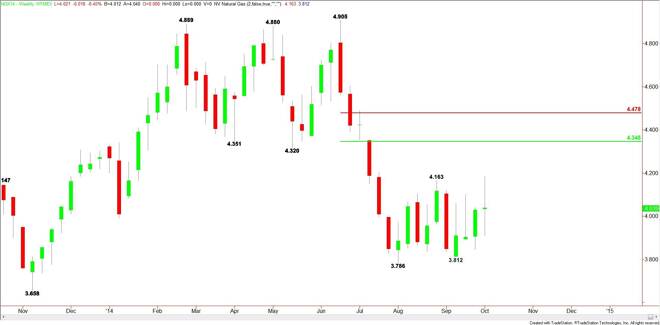Advertisement
Advertisement
Natural Gas Weekly Fundamental Analysis, October 6 – October 10, 2014 Forecast
By:
Weekly November natural gas futures tried to breakout to the upside early last week, but failed to attract enough buying interest to complete the move.
Weekly November natural gas futures tried to breakout to the upside early last week, but failed to attract enough buying interest to complete the move. The strength early in the week was created by a forecast for below-normal temperatures across the high demand areas of the U.S. The rally failed when the forecast was changed to normal temperatures.
The current price action is typical for October because temperatures and weather conditions often shift from bullish to bearish during this time period. Since it is fall in the U.S., this type of temperature fluctuation should be expected because the season is usually neither too hot nor too cold.
Traders refer to this time period and price action as the “shoulder season”. This is a seasonal time period when mild temperatures spread across the main gas consuming regions, holding demand steady. It also represents a time when producers replenish supply ahead of the winter season. If producers fall short of expectations and winter conditions appear earlier than normal, the market starts to rally.
Price consolidation, or sideways action typically takes place during the “shoulder season” because speculators support the market on concerns that supplies may not be adequate enough for the upcoming heating season.
This year is no exception. Since bottoming the week-ending August 1, prices have consolidated inside a relatively tight trading range. The catalyst behind this formation is based on the assessment from the U.S. Energy Information Administration which in September reported that stockpiles of power-plant fuel were 13 percent below the five-year average and 11 percent lower than a year earlier.
Since volatility has been low during this consolidation time period, one should expect increased price action once the cold weather is added to the low supply equation. This combination of relatively low supplies combined with the return of normal cold temperatures could be the final catalyst that triggers the start of the winter rally.
Basically, we are looking at this scenario in the natural gas market. Supply is currently below last year’s level for this time of the year. This is why the current bottom is higher than last year’s bottom. During this mild weather time period, producers are injecting as much gas into storage as possible. At the same time, the clock is ticking on the start of the winter heating season. If the cold weather hits and the supply is not adequate then prices should rise.
Look for more consolidation this week unless cold weather becomes an issue. Then look for a spike to the upside. What bullish traders would like to see is a new expanded forecast calling for below-normal temperatures.
About the Author
James Hyerczykauthor
James is a Florida-based technical analyst, market researcher, educator and trader with 35+ years of experience. He is an expert in the area of patterns, price and time analysis as it applies to futures, Forex, and stocks.
Did you find this article useful?
Latest news and analysis
Advertisement
